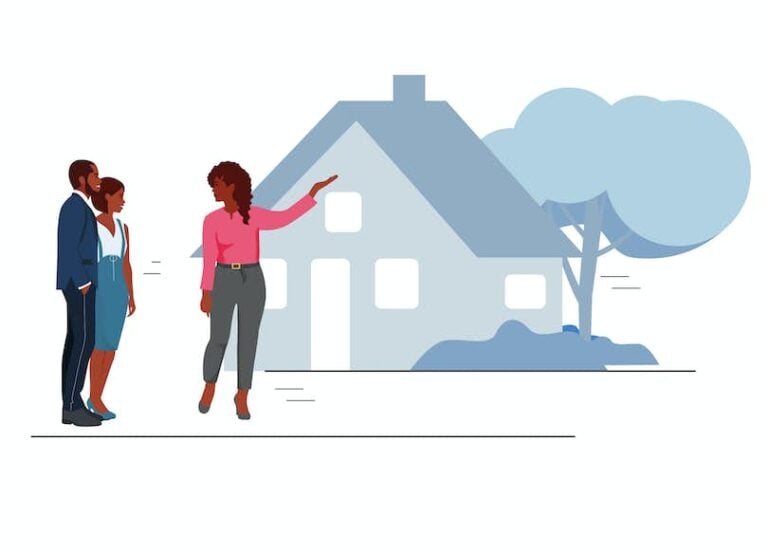Buying a house in Texas can be both an exciting and confusing process, especially for first-time home buyers. Our guide breaks down how to buy a house in Texas in eight steps, with insights and practical tips to help you navigate Texas' real estate market.
⚡️ Start the search: Get matched with vetted real estate agents near you!
Key steps to buying a house in Texas
Step 1: Save for a down payment. » Most mortgage lenders in Texas want you to contribute 20% of the purchase price as a down payment, but buyers in Texas have access to state loan programs or federal loans that can help cover (or reduce) the down payment cost.
Step 2: Find an agent. » Your real estate agent is your ally in the home buying process. Take time to interview multiple agents to find the best fit. Top agents have insider knowledge about specific neighborhoods and are excellent communicators.
Step 3: Get pre-approved and maintain your credit score. » Pre-approval determines your budget. But if your credit score drops, it could complicate (or derail) the closing process. While you house hunt, pay your cards on time and avoid opening or closing new credit accounts.
Step 4: Find a location. » As you search for a new place to live, check that local amenities like parks, shops, and restaurants support your lifestyle. You might also want to look at housing price trends: rising values in the area are a good sign that your new Texas home will appreciate, too.
Step 5: Go house hunting. » As housing prices continue to increase, finding a house that fits your budget and checks all your boxes might be challenging. An experienced agent can help target homes that meet your must-haves while staying within budget.
Step 6: Make an offer. » Heed your realtor’s advice when crafting an offer. Your agent knows the local area and can guide you in writing a competitive offer that wins the house while meeting your budget.
Step 7: Get an inspection and appraisal. » You need to hire an appraiser to determine how much the house is currently worth — and an inspector to assess the home’s condition and spot any unexpected or unseen issues.
Step 8: Close. » A final walk-through helps ensure that the house is in the same condition as when you made the offer before you close on your new home. You also need to finalize the paperwork for the sale and complete the forms from escrow.
Step 1: Save for a down payment
Your down payment is the first part of your home's purchase price that you pay at closing. Your mortgage lender pays the remaining balance.
A down payment can be up to 20% of the home's final purchase price. In Texas, that could mean paying up to $59,725 for a $298,624 home.
If you put less money down, your lender will typically require you to get private mortgage insurance (PMI) on the loan. That can save you money up front but increase your monthly mortgage payments and total interest costs over the life of the loan.
However, if you can't afford to put that much down at closing, or want to hold onto more of your cash to cover other home-buying expenses, some government-backed loans have lower down payment mortgage options than conventional loans.
| Mortgage type | Minimum down payment (%) | Down payment ($) |
|---|---|---|
| Conventional | 20%, or <20% + PMI | $8,959 |
| Federal Housing Administration loan | 3.5% | $10,452 |
| Veterans Affairs loan | 0% | $0 |
Texas down payment assistance programs
There are several down payment assistance (DPA) programs that are designed with Texas residents in mind. If you qualify for one of these mortgage loan programs, you could receive a grant or a second mortgage to cover your closing costs or down payment.
Here are just a few DPA programs in Texas that you might be eligible for:
My First Texas Home program
The My First Texas Home program offers first-time buyers and veterans a 30-year, low-interest mortgage and up to 5% of the loan amount, which can be used as an interest-free down payment or closing cost assistance.
The first mortgage must be from a lender approved by the Texas Homebuyer Program, and eligible borrowers must have a minimum credit score of 620. Home purchase price and income limits apply and vary by county.
My Choice Texas Home program
The My Choice Texas Home program offers a first mortgage with an option to add down payment assistance of up to 5%. Down payment assistance comes as a 30-year, 0% interest second mortgage.
This program is available to first-time and repeat home buyers with credit scores of 620 or better. Home purchase price and household income limits apply and vary by county.
TSAHC Home Sweet Texas Home program
The Texas State Affordable Housing Corporation (TSAHC) gives eligible home buyers a grant or a deferred forgivable second loan through its Home Sweet Texas Home Loan program.
To qualify, the borrower must have a credit score of at least 620. Home purchase price and household income limits apply and vary by county.
U.S. Department of Housing and Urban Development
Additional DPA resources in Texas can be found on the state's HUD page.
More about low down payment home loans
Government-backed loans, like FHA loans, allow a minimum down payment of 3.5% toward your home's purchase. Conventional mortgages typically require higher down payments and a good credit score, but some allow for down payments as low as 3–5%, though the minimum varies by lender.
But making a down payment of less than 20% comes with some risks:
- Because you're borrowing more money, you'll have higher monthly payments and pay more in interest over the life of your loan.
- Putting less than 20% down means you'll pay additional PMI, which protects the lender from potential losses.
| Down payment | Monthly payment | Total interest | Total cost |
|---|---|---|---|
| 5% | $1,893 | $397,836 | $696,460 |
| 20% | $1,594 | $335,019 | $633,643 |
Mortgage insurance costs range from 0.5% to 6% of your annual mortgage balance and is added to your mortgage payment each month. However, rates vary based on your down payment, credit score, and loan type:
- Conventional loans require PMI until you've built up 20% equity in the home (for example, until you owe $400,000 on a $500,000 home). Some lenders require proof that your home has increased in value enough to cancel the PMI.
- FHA loans require a mortgage insurance premium (MIP) for the life of your loans, regardless of your home equity. FHA loans can work well for first-time home buyers who have a poor credit score.
- VA loans don't charge mortgage insurance. Instead, you'll pay a one-time VA loan funding fee at closing, which can range from 1.4% to 3.6% of the purchase price. VA loans are available only to veterans, active service members, and eligible surviving spouses.
» LEARN MORE: Everything you need to know about low-income home loans
Step 2: Find a great local real estate agent in Texas
Whether you're actively house hunting or just starting to browse homes on Zillow, it's never too early to find a great Texas realtor to guide you on your search. An experienced agent can help you navigate a tricky housing market, explore your financial options, and negotiate the best deal possible in the Lone Star State.
In addition to finding and showing you properties, your agent will help you make offers, negotiate contracts, and navigate the closing process. Plus, they can recommend other service providers (like title companies and inspectors) to help you buy your home in Texas — just remember you can always shop around!
Best of all, hiring a good local real estate agent comes at no extra cost to you — sellers typically pay all realtor fees from the home sale — and can get you the best price on a home.
Why leave extra money on the table? Clever can connect you with one of the top real estate agents in your area, plus put cash back in your pocket.
With Clever:
✅ You'll work with a full-service realtor from a top broker
✅ You'll earn cash back on qualifying purchases
✅ It's free, with zero obligation — you can walk away at any time
Fill out the form below to get started!
When finding and choosing a Texas realtor, consider their local knowledge and proximity to the specific neighborhoods you're interested in.
For example, if you're moving for a job in Houston, an agent could have intimate knowledge of Greater Heights but not Kingwood. If you don't know exactly where you're moving to yet, you can reach out to agents who specialize in the City of Houston.
You can start your search by looking up a brokerage or realty, but don't stop there. Take the time to research and interview multiple real estate agents, paying attention to their:
- Years of experience (the median is 8 years)
- Number of home buyers helped in the last year — the more the better!
- Expertise in your target neighborhood and price range
- Online reviews and complaints
- Licensing and certifications, such as an Accredited Buyer's Representative
- Membership in local real estate boards, such as the Greater Fort Worth Association of Realtors or the Texas Real Estate Commission
Step 3: Get pre-approved for a mortgage
Mortgage pre-approval is a lender's conditional offer to lend you a maximum amount of money to buy a home.
Most sellers in Texas will ask for a mortgage pre-approval letter before showing you their home. It demonstrates that you're financially qualified to make an offer and can give you an advantage over buyers who don't have one.
Pre-approval can be as simple as a 40-minute phone call with your lender, a credit score check, and sending them your proof of funds. Once you make an offer on a house in Texas, you'll start the initial mortgage application.
Pre-approval vs. pre-qualification
Pre-approval is a more in-depth analysis of your finances than pre-qualification and serves as a more formal commitment from a lender. It usually requires a hard credit check and supporting documentation, such as paycheck stubs and W-2s.
Pre-qualification gives you a basic idea of what you might be able to borrow based on a quick look at your finances.
Does pre-approval hurt my credit score?
✍️ Tip: If you get pre-approved with multiple lenders within a 45-day window, it will only count as one credit inquiry, minimizing the impact on your score.
The savings you'll gain from shopping around for a mortgage pre-approval will likely far outweigh any minor, short-term impacts to your credit.
What do mortgage lenders review?
To figure out if they can pre-approve you for a mortgage loan, mortgage companies usually check your:
- Credit report
- Credit score
- Payment history
- Monthly income
- Debt-to-income ratio
- Employment
(Note: These are the same factors that determine the loan's interest rate.)
You're evaluating lenders, too.
Consider each lender's quoted mortgage interest rates, estimated closing costs and fees, reputation and online reviews, customer service quality, and responsiveness to your questions.
Although you don't have to decide on a mortgage lender now, you should compare interest rates and pre-approval amounts from several lenders to make sure you're getting the absolute best rate and terms when you're ready to buy your house in Texas.
A local mortgage lender:
- Might provide you with more market-specific information, such as typical home values in your desired area
- Likely has a better understanding of lending regulations in the state
- Can connect with you other real estate professionals (realtors, contractors, inspectors, etc.)
You don't necessarily need to use a Texas-based lender when buying a home in the state. Many national and online lenders are licensed to provide mortgage loans in Texas and may provide better rates and terms.
Step 4: Choose the right location
Start zooming in on the best neighborhoods where home prices fall within your budget, and consider what you want out of your home.
If home equity is most important to you, search where home values are rising the most. But don't forget about local culture and amenities that fit your lifestyle.
Texas home prices
Currently, the typical home value in Texas is $298,624, but prices vary dramatically from city to city and even from neighborhood to neighborhood!
Home value appreciation in Texas
| Neighborhood | 2015 | Current | Appreciation |
|---|---|---|---|
| Northeast Dallas | $222,110 | $465,173 | 52.3% |
| Far North | $291,635 | $551,253 | 47.1% |
| Southeast Dallas | $76,996 | $229,973 | 66.5% |
Lifestyle
Talking to a local realtor can be huge when buying a home, especially in Texas's competitive market. They'll provide a unique perspective, with in-depth knowledge of neighborhoods and their potential for appreciation over time.
A good local agent can also provide tailored housing recommendations based on your lifestyle, such as information on the best schools, local amenities, and traffic patterns.
Where should you buy a house in Texas? Start here
Step 5: Start house hunting in Texas
📊 Key local data:
- Median mortgage interest rate: 7.03%
- Median home value: $298,624
- Best month for house hunting (highest inventory): June
- Median lot size: 9,540 square feet (one of the smallest in the country)
- Most popular home type: Single-family residence
Searching for homes in Texas is the fun part of the home buying process! You'll get to look at a variety of available listings and discover what you really want in a home.
Make a list of everything you want in a home and prioritize them by must-haves (such as proximity to work or your children's school) versus your nice-to-haves (like a spacious garage or backyard).
Consider the full costs of owning a home, not just the mortgage payment. Other potential costs of owning the home include maintenance and repairs, property taxes, homeowner's insurance, and HOA fees.
Your realtor can help you understand which of your needs and wants fit your budget and favorite neighborhoods and adjust where possible.
You should also decide whether you'll only visit homes in person or if you trust your agent to visit the properties on your behalf. This can be useful if you work demanding hours and can't always be available to see a house.
Next, your agent will search for homes on your local MLS and bring you top picks, and you'll schedule viewings and tours.
Step 6: Make an offer
Once you find a Texas house you love, it's time to make an offer. Your real estate agent will help you write a compelling offer that gives you the best shot of convincing the homeowner to sell to you.
Talk to your real estate agent to work out all your contingencies and concessions so you can act quickly and make a strong offer that gives you a good chance of winning the home.
Part of your offer could include an earnest money deposit, which may be 1–2% of the purchase price. It's an incentive for the sellers to take the home off the market until closing. If the sale goes through, the earnest money deposit goes toward your down payment, so it won’t cost you won't be anything additional out of pocket.
Note: When housing inventory is high, so is demand. So if you're house-hunting in June, you may have less time to make an offer than in December.
Average time homes spend on market in Texas
| Annual average | 60 |
| January | 70 |
| February | 60 |
| March | 50 |
| April | 46 |
| May | 46 |
| June | 45 |
| July | 45 |
| August | 48 |
| September | 52 |
| October | 55 |
| November | 59 |
| December | 65 |
Source: Realtor.com (March 2024)
Step 7: Inspections, appraisals, and financing
Once the seller accepts your initial offer, you have to do due diligence before officially purchasing the home. Inspections let you better evaluate the home's condition, and lenders use appraisals to determine value and decide how much your final loan amount will be.
If something unexpected pops up or if the home's appraised comes in below the purchase price, you could have an opportunity to renegotiate the terms of your contract.
Underwriting
This is also the period that your lender will verify that you can afford your mortgage. They may ask for proof of income, pay stubs, and letters of explanation for income that doesn't come from wages, and other loan statements (like for student debt).
Delays could lead to postponed closing, so start collecting this information early so that you can be ready to submit documents when your lender asks.
Home inspections in Texas
Having your Texas home inspected by a licensed inspector gives you peace of mind about the condition of the property before you commit thousands of dollars to purchase it. A licensed professional checks the house for any unseen, unexpected, or potential issues.
Your inspector should check out the following parts of the property:
- Roof
- Foundation
- Electrical system
- HVAC system
- Plumbing
A home inspection costs around $300 to $600, depending on factors like the home's location, condition, and age.
If the home has a septic system, you should also pay for a septic inspection to make sure it doesn't have any problems that wouldn't be covered in a typical home inspection.
Texas-specific inspections
Texas law requires sellers to disclose all known problems with a property to interested buyers. However, some issues can go unnoticed until serious damage has occurred.
Before closing on a home, we strongly recommend home buyers to order specialized tests in addition to a general home inspection, such as:
- Radon testing: If the seller hasn't conducted a radon test within the past year, it's a good idea to do a test yourself. Elevated levels of radon can cause long-lasting health issues if the issue isn't mitigated quickly. You can request a free radon test kit from the Texas Radon Group.
- Termite and pest inspection: Termites and other pests can cause property damage and pose health risks to residents long before they're noticed by inhabitants. Even if a seller is confident their property is pest-free, it's a good idea to have a professional inspection done to give yourself peace of mind.
Appraisals
Appraisals determine the value of the property. If you're using a mortgage to buy your new home, your lender will order an appraisal to make sure the home is worth the money that it's loaning you.
» LEARN: 3 options for buyers after a low appraisal
Step 8: Close on your new home!
Final walk-through
Before you close on your new home, you and your agent will do a final walk-through of the property to ensure that it's still in the expected condition. You'll want to check to make sure:
- The appliances are in working order.
- Any agreed-upon repairs were handled by the seller.
- There was no damage to the home when the seller moved out.
Closing day
On the closing date, you’ll meet at the title company or with real estate attorneys to review lots of important paperwork. You'll need to read and sign several documents, including:
- The final loan application
- The deed transfer
- Various disclosures
Before signing anything, ask your agent or closing attorney about any questions you have to make sure you fully understand each document.
After completing the paperwork, you'll have to pay for closing costs. The title company will collect the total amount you owe for various services and pay each party on your behalf.
Typically, a buyer's closing costs can be separated into four categories:
- Prepaid costs: Ongoing costs of homeownership, such as property taxes and homeowners insurance. Mortgage lenders often require buyers to pay these monthly fees up front.
- Title and escrow charges: Charges for the title company's services, such as title searches and title insurance.
- Lender fees: Fees for the mortgage company to originate and underwrite your loan. Lender fees might include other expenses associated with your loan, such as appraisal fees or mortgage points.
- Other closing costs: Miscellaneous costs unique to each buyer. Other closing costs can include pest inspection fees, natural disaster certification fees, and other variable expenses.
Buyers in Texas typically pay 3%–5% of the purchase price in closing costs. For a $298,624 home — the typical home value in Texas — that's between $8,958 and $14,930!
After signing all of the paperwork, you'll get the keys and can move into your new home. Congrats!
Start of mortgage payments
If you took out a mortgage to purchase the home, your first loan payment is likely due within a month after closing.
Ask your lender for more specific details about the payment schedule, how to make the first payment, and how to set up automatic payments (if desired).
Why trust us?
Clever Real Estate is a free agent-matching service that has helped more than 82,000 people buy and sell homes. We partner with over 2,700 top-performing agents nationwide at national brokers including Keller Williams, RE/MAX, Century 21, and more. We also help buyers save money with cash back after closing.
We’ve earned buyers’ trust with a rating of 5 out of 5 stars on Trustpilot and over 3,000 customer reviews in total.
Our team of industry-leading researchers is committed to making homeownership more accessible by educating buyers through guides like this one. We've spent thousands of hours analyzing publicly available data, surveying consumers, and interviewing industry experts. Our research has been featured in The New York Times, Business Insider, Inman, Housing Wire, and many more.






